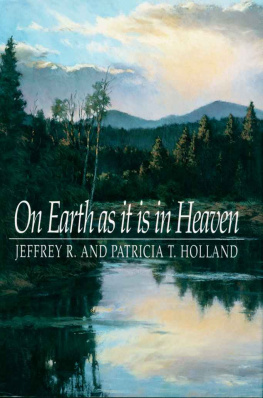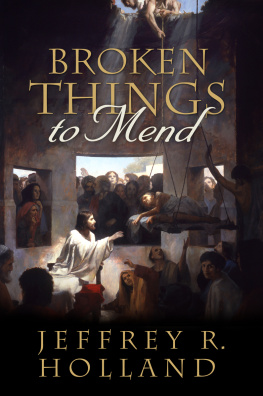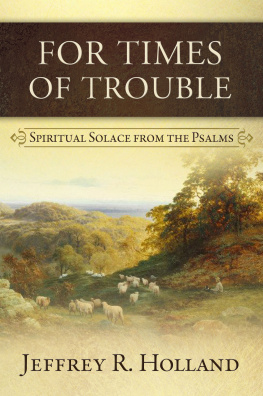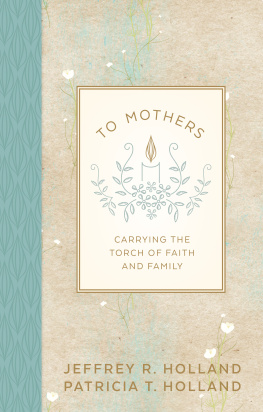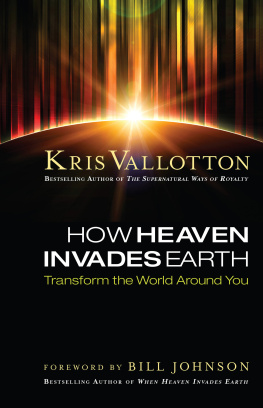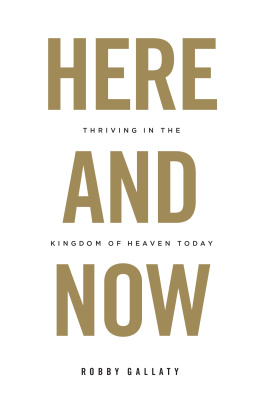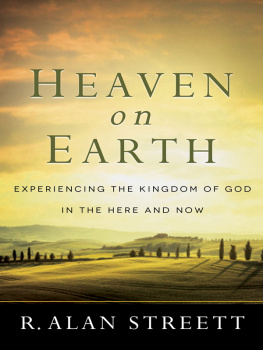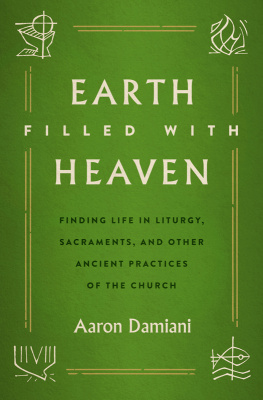On Earth As It Is in Heaven
Jeffrey R. Holland, Patricia T. Holland
1989 Jeffrey R. Holland and Patricia T. Holland.
All rights reserved. No part of this book may be reproduced in any form or by any means without permission in writing from the publisher, Deseret Book Company, P.O. Box 30178, Salt Lake City Utah 30178. This work is not an official publication of The Church of Jesus Christ of Latter-day Saints. The views expressed herein are the responsibility of the author and do not necessarily represent the position of the Church or of Deseret Book. Deseret Book is a registered trademark of Deseret Book Company.
To Matt, Mary, and Duff
For creating our heaven on earth
PREFACE
Life here in mortality has a generous number of challenges for every one of us, and frequently we find ourselves longing for some of the peacefulness and safety of heaven. The Savior expressed not only the wish of his own heart but also that of every one of his disciples when he prayed to his Father, "Thy kingdom come, Thy will be done on earth as it is in heaven." Until we can be safely home in heaven, with God and with each other, surely there is nothing higher for which we could hope than that his will and way and divine influence would be fully felt here on earth.
Such a pure and strong society will probably never be possible until Christ's millennial reign as King of kings and Lord of lordsbut that is no excuse not to try to make his "kingdom come" sooner wherever that may be possible. And although heavenly circumstances may not come broadly and generally until that second advent, there are profound ways in which they can come to us personally, to our families, and to clusters of believers who live the gospel in their hearts and homes and neighborhoods.
Surely the key to any success in time or eternity is through obedience to the Son of God and his teachings, even as he was totally obedient to the will of his Father "in all things." This book, a collection of some of our talks and essays, is devoted to those aspects of life near at hand in which we have the opportunity to make God's will our will and his ways our ways. It is devoted to the ideal of making life here "on earth" as much as possible as it is "in heaven."
ACKNOWLEDGMENTS
We wish to thank manyespecially the students of Brigham Young Universitywho were willing to listen to these ideas long before they came into book form. It was the privilege of a lifetime to work with such remarkable and responsive young people.
We thank a number of secretaries over the years, especially Jan Nelson and Shauna Brady, who produced untold drafts of these manuscripts. Jan Nelson also produced the final copy for this book. Special appreciation is expressed to Eleanor Knowles, executive editor of Deseret Book, who had the initial idea for this project and whose patience saw it through to publication.
PERCEPTIONS AND REFLECTIONS
by Patricia T. Holland
Chapter 1
FILLING THE MEASURE OF OUR CREATION
Every element of creation has its own purpose and performance, its own divine role and mission. If our desires and works are directed toward what our heavenly parents have intended us to be, we will come to feel our part in their plan. We will recognize the "full measure of our creation," and nothing will give us more ultimate peace.
When my daughter, Mary, was just a small child, she was asked to perform a talent for a PTA contest. This is her experience exactly as she wrote it in her seven-year-old script:
"I was practicing the piano one day and it made me cry because it was bad. Then I decided to practice ballet, and it made me cry moreit was bad too. So then I decided to draw a picture because I knew I could do that good, but it was horrid. Of course it made me cry.
"Then my little three-year-old brother came up and I said, 'Duffy, what can I be? What can I be? I can't be a piano player or an artist or a ballet girl. What can I be?' He came up to me and whispered, 'You can be my sister.' "
In an important moment, those five simple words changed the perspective and comforted the heart of a very anxious child. Life became better right on the spot and, as always, tomorrow was a brighter day.
All of us face those questions about our role, our purpose, our course in lifeand we face them long after we are children. I visit with enough women to know that many, perhaps most, have occasions when they feel off balance or defeatedat least temporarily. And we ask, "What will I be? When will I graduate? Whom will I marry? What is my future? How will I make a living? Can I make a contribution? In short, what can I be?"
Take heart if you are still asking yourself such questions because we all do. We should concern ourselves with our fundamental purposes in life. Surely every philosopher past and present agrees that, important as they are, food and shelter are not enough. We want to know what's next. Where is the meaning? What is my purpose?
When asking these questions, I have found it extremely reassuring to remember that one of the most important and fundamental truths taught in the scriptures and in the temple is that "every living thing shall fill the measure of its creation."
I must admit that when I first heard this directive, I thought it meant only procreation, having issue, bearing offspring. And I'm sure that is probably the most important part of its meaning. However, much of the temple ceremony is symbolic, so surely there can be multiple meanings in this statement as well. Part of the additional meaning I now see in this commandment is that every element of creation has its own purpose and performance; every one of us has been designed with a divine role and mission in mind. I believe that if our desires and works are directed toward what our heavenly parents have intended us to be, we will come to feel our part in their plan. We will recognize the "full measure of our creation," and nothing will give us more ultimate peace.
I once read a wonderful analogy of the limitations our present perspective imposes on us. The message was that in the ongoing process of creationour creation and the creation of all that surrounds usour heavenly parents are preparing a lovely tapestry with exquisite colors and patterns and hues. They are doing so lovingly and carefully and masterfully. And each of us is playing a partour partin the creation of that magnificent, eternal piece of art.
But in doing so we have to remember that it is very difficult for us to assess our own contribution accurately. We see the rich burgundy of a neighboring thread and think, "That's the color I want to be." Then we admire yet another's soft, restful blue or beige and think, "No, those are better colors than mine." But in all of this we don't see our work the way God sees it, nor do we realize that others are wishing they had our color or position or texture in the tapestryeven as we are longing for theirs.
Perhaps most important of all to remember is that through most of the creative period, we are confined to the limited view of the underside of the tapestry where things can seem particularly jumbled and muddled and unclear. If nothing really makes very much sense from that point of view, it is because we are still in process and unfinished. But our heavenly parents have the view from the top, and one day we will know what they knowthat every part of the artistic whole is equal in importance and balance and beauty. They know our purpose and potential, and they have given us the perfect chance to make the perfect contribution in this divine design.

